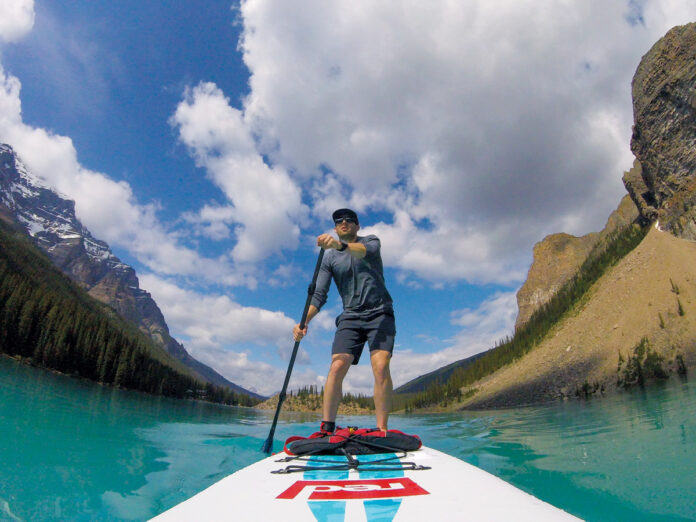
If you haven’t tried a stand-up paddleboard (SUP), you probably want to – it’s fun and not too difficult. And it’s one of the fastest growing sports in North America.
Enthusiasts tout SUP as a relaxing activity that gets you into nature, improves mental health and allows you to reach remote, secluded places. And they’re not terribly expensive, beginning at around $500.
“The great thing about SUP is that everyone can try it,” explains Madison Nesom, a certified SUP instructor at Aquabatics in Calgary. “It doesn’t require much to jump on a board and paddle around the lake. If you fall, at least it’s a soft landing.”
In addition to being a fun way to experience the water, SUP provides a low impact cardio workout that uses your whole body. It’s particularly good for the core as even on flatwater, SUPs are somewhat wobbly, requiring good balance skills. By the end of a paddle, you’ll be feeling your abdominal, shoulder, back, chest and leg muscles. You’ll also burn calories – around 350 for leisurely paddling and up to 1,100 per hour for SUP racing.
“Most people struggle with standing up at first,” says Nesom. “Other than standing, the biggest challenge is understanding the correct paddling techniques that will save you from exhaustion or injuries. Also, I almost always have to tell people they’re holding their paddle backwards!”
SUP is proving to be an adaptable water sport that can be practiced on virtually any body of water. They’re being used for surfing, fishing, yoga, racing and leisurely exploration. Some paddlers are even touring with their boards, going on extended trips with supplies and equipment strapped fore and aft.
Others are taking SUPs to extremes. In 2018 SUP Multi-World Champ Casper Steinfarth became the first person to cross the frigid, 130km Skaggerak Straight, between Norway and Denmark on an SUP. Others are tracing the Amazon River, circumnavigating islands and participating in events like the Yukon 1,000 which had formerly been raced in canoes and kayaks only.
If you’re itching to try out this growing sport, there are a wealth of companies providing lessons and outings for beginners. And don’t forget to wear your bathing suit; you’re sure to make a splash.
SUP For Fitness?
Most of the benefits of SUP are anecdotal and only a few studies have measured its impact. However, one small study published in BMC Sports Science Medical Rehabilitation by Schram et al. showed increased aerobic (24%) and anaerobic fitness (42%) in beginners who paddled on an SUP simulator three hours a week for six weeks. Core strength improved by about 27% and participants reported a 17% improvement in mental health.
Considering how much force is required to pull a paddle through the water, it’s not surprising SUP is a good workout.
















